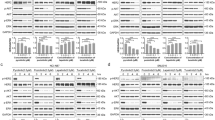Abstract
Objective
To further validate a knockdown approach for circumventing the multidrug resistance gene (MDR1), we used small interfering RNA(siRNA) targeting MDR1 gene to inhibit the expression of MDR1 gene and P-glycoprotein(P-gp) in vivo.
Methods
Ascite tumor xenografts were established by implanting human ovarian carcinoma cells SKOV3/AR intraperitoneally into the nude mice. The mice were randomized into the following three treatment groups with each group six mice respectively: Taxol, Taxol with lipofectamine and Taxol with siRNA/MDR1-lipofectamine intraperitoneal injection. The tumor growth rate and the ascite growth rate of mice were investigated. The expressions of MDR1 gene and P-gp in mice were determined by reverse transcription-polymerase chain reaction(RT-PCR) and immunohistochemistry respctively.
Results
The growth of tumors and ascites in mice treated with Taxol and siRNA/MDR1-lipofectamine was significantly inhibited compared with those in mice of other groups. After 28 days’ treatment, the average tumor weight and ascite volume decreased by 43.6% and 29.7% in the group treated with Taxol and siRNA/MDR1-lipofectamine compared with these treated with Taxol alone (P<0.001). The expressions of MDR1 gene and P-gp in the group treated with Taxol and siRNA/MDR1-lipofectamine were also decreased compared with those in the group treated with Taxol alone (P<0.001).
Conclusion
Small interfering RNA targeting-MDR1 can effectively and specifically suppress the expression of MDR1(P-glycoprotein) and inhibit ovarian cancer growth in vivo.
Similar content being viewed by others
References
Roberts PC, Mottillo EP, Baxa AC, et al. Sequential molecular and cellular events during neoplastic Progression:a mouse syngeneic ovarian cancer model[J]. Neoplasia 2005;7: 944–956.
Shabbits JA, Mayer LD. P-glycoprotein modulates ceramide-mediated sensitivity of human breast cancer cells to tubulin-binding anti-cancer drugs [J]. Mol Cancer Ther 2002;1: 205–213.
Hsiao P, Bui T, Ho RJ, et al. In vitro-to-in vivo prediction of P-glycoprotein-based drug interactions at the human and rodent blood-brain barrier[J]. Drug Metab Dispos 2008; 36: 481–484.
Jekerle V, Kassack MU, Reillv RM, et al. Functional comparison of single and doublestranded mdr1 antisense oligodeoxy-nucleotides in human ovarian cancer cell lines[J]. J Pharm Pharmaceut Sci 2005; 8:516–527.
Chen XP, Wang Q, Guan J, et al. Reversing multidrug resistance by RNA interference through the suppression of MDR1 gene in human hepatoma cells[J]. World J Gastroenterol 2006;12:3332–3337.
Zhi S, Liang YJ, Chen ZS, et al. Reversal of MDR1/P-Glycoprotein-mediated multidrug resistance by vector-based RNA interference in vitro and in vivo[J]. Cancer Biol Ther 2006; 5: 39–47.
Pichler A, Zelcer N, Prior J. et al. In vivo RNA interference-mediated ablation of MDR1 P-glycoprotein[J]. Clin Cancer Res 2005; 11: 4487–4494.
Wu H, Hait WN, Yang JM. Small interfering RNA-induced suppression of MDR1 (P-glycoprotein) restores sensitivity to multidrug-resistant cancer cells[J]. Cancer Res 2003; 63: 1515–1519.
Wang R, Dong K, Lin F, et al. Inhibiting proliferation and enhancing chemosensitivity to taxanes in osteosarcoma cells by RNA interference-mediated downregulation of Stathmin expression[J]. Mol Med 2007; 13: 567–575.
Santel A, Aleku M, Keil O, et al. RNA interference in the mouse vascular endothelium by systemic administration of siRNA-lipoplexes for cancer therapy[J]. Gene Ther 2006; 13:1360–1370.
Nie CL, Gao GL, Han J, et al. Human papillomavirus 16 E6, E7 siRNAs inhibit proliferation and induce apoptosis of SiHa cervical cancer cells[J]. Chin J Cancer Res 2008; 20: 301–306.
Minakuchi Y, Takeshita F, Kosaka N, et al. Atelocollagen-mediated synthetic small interfering RNA delivery for effective gene silencing in vitro and in vivo[J]. Nucleic Acids Res 2004; 32:e109.
Seibler J, Kleinridders A, Küter-Luks B, et al. Reversible gene knockdown in mice using a tight, inducible shRNA expression system[J]. Nucleic Acids Res 2007; 35: e54.
Duan ZF, Brakora KA, Seiden MV. Inhibition of ABCB1 (MDR1) and ABCB4 (MDR3) expression by small interfering RNA and reversal of paclitaxel resistance in human ovarian cancer cells[J]. Mol Cancer Ther 2004; 3: 833–838.
Piva R, Chiarle R, Manazza AD, et al. Ablation of oncogenic ALK is a viable therapeutic approach for anaplastic large-cell lymphomas[J]. Blood 2006; 107: 689–697.
Czauderna F, Fechtner M, Aygün H, et al. Functional studies of the PI(3)-kinase signalling pathway employing synthetic and expressed siRNA[J]. Nucleic Acids Res 2003; 31: 670–682.
Pulukuri SM, Gondi CS, Lakka SS, et al. RNA interference-directed knockdown of urokinase plasminogen activator and urokinase plasminogen activator receptor inhibits prostate cancer cell invasion, survival and tumorigenicity in vivo[J]. J Biol Chem 2005; 280: 36529–36540.
Xu D, McCarty D, Fernandes A, et al. Delivery of MDR1 small interfering RNA by self-complementary recombinant adeno-associated virus vector[J]. Mol Ther 2005; 11: 523–530.
Xie SM, Fang WY, Liu Z, et al. Lentivirus-mediated RNAi silencing targeting ABCC2 increasing the sensitivity of a human nasopharyngeal carcinoma cell line against cisplatin[J]. J Transl Med 2008; 6:55.
Schiffelers RM, Ansari A, Xu J, et al. Cancer siRNA therapy by tumor selective delivery with ligand-targeted sterically stabilized nanoparticle [J]. Nucleic Acids Res 2004; 32:e149.
Xiao H, Wu Z, Shen H, et al. In vivo reversal of P-glycoprotein-mediated multidrug resistance by efficient delivery of Stealth™ RNAi[J]. Basic Clin Pharmacol Toxicol(in Chinese) 2008;103: 342–348.
Sersa G, Miklavcic D, Cemazar M, et al. Electrochemotherapy in treatment of tumors[J]. Eur J Surg Oncol 2008; 34:232–240.
Author information
Authors and Affiliations
Corresponding author
Additional information
This work was supported by the grant from the key project of Jiangxi Bureau of Health Science(No.200506).
Rights and permissions
About this article
Cite this article
Liu, Fj., Gao, Gl., Tu, Kj. et al. Small interfering RNA targeting MDR1 inhibits ovarian cancer growth and increases efficacy of chemotherapy in vivo . Chin. J. Cancer Res. 21, 318–324 (2009). https://doi.org/10.1007/s11670-009-0318-y
Received:
Accepted:
Published:
Issue Date:
DOI: https://doi.org/10.1007/s11670-009-0318-y




